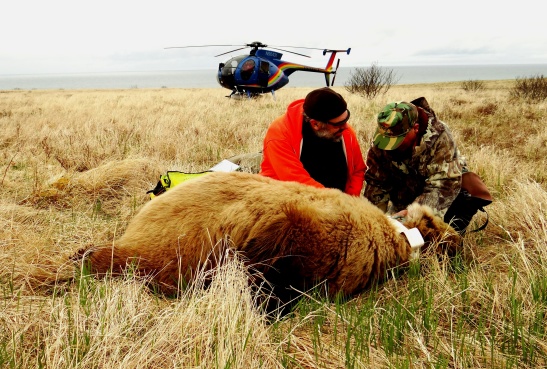Native Americans and brown bears have coexisted in the Kodiak archipelago for thousands of years. Here in the western Gulf of Alaska, a rich coastal ecosystem and genetic isolation has led to the evolution of the legendarily large Kodiak brown bear subspecies. Hunting these famous bears is not only a spiritual experience, but provides Native Alaskans with a valuable food source, clothing materials and cultural products.
SCI Foundation supports a continuing research project on Sitkalidak Island with a collaborative stakeholder group, including the Alaska Department of Fish and Game, the Kodiak Brown Bear Center, Kodiak Brown Bear Trust, and the Old Harbor Native Corporation. Over the last nine years, this team has tracked 30 female bears and gathered tons of data on the overall population.
With the introduction of cattle ranching in the early 1900s, the population of brown bears was nearly wiped out. In 1964, however, a devastating tsunami left the island uninhabited. Bears were able to recolonize the area, and slowly their numbers began to recover. Today, Sitkalidak Island hosts some of the best hunting opportunities in the region.

Capturing, radio collaring and monitoring the sample of female bears has led to valuable results in understanding survival and cub production. The mean litter size and survival were found to be greater than other areas and coastal bear populations. This high productivity has contributed to a thriving population on the island, with a healthy level of hunting harvest. All of this research provides the baseline information to wildlife managers setting area specific harvest quotas.
Recent harvest information from the Kodiak Unified Bear Subcommittee indicates an abundant and growing population. Through the 2016 spring and fall seasons, a total 200 bears were harvested.
The Kodiak Brown Bear Project is also studying the impact of logging on seasonal movements and distribution of bears on the nearby Afognak Island. This research is combined with a study investigating the effect of bear predation on elk calves. Eight bears are currently collared as part of this effort, with the goal of capturing and monitoring 40.
The project presented these research results at the International Bear Association Conference in 2016, where five SCI Foundation sponsored projects participated. SCI Foundation expects more data and results from the upcoming 2017 spring season.
Watch this short video below to learn more about the Kodiak Brown Bear Project!
